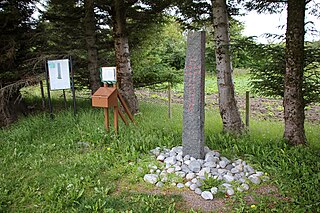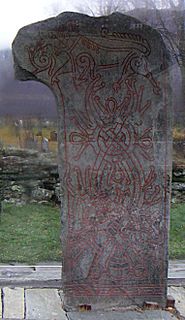 W
WThe sequence alu is found in numerous Elder Futhark runic inscriptions of Germanic Iron Age Scandinavia between the 3rd and the 8th century. The word usually appears either alone or as part of an apparent formula. The symbols represent the runes Ansuz, Laguz, and Uruz. The origin and meaning of the word are matters of dispute, though a general agreement exists among scholars that the word represents an instance of historical runic magic or is a metaphor for it. It is the most common of the early runic charm words.
 W
WThe Dynna Stone is a runestone from the late Viking Age that was originally located in Gran, Norway.
 W
WThe Einang stone (Einangsteinen) is a runestone located east of the Einang Sound near Fagernes, in Oppland, Norway, notable for the age of its runic inscription. The Einang runestone is located within the extensive Gardberg site. It is placed on a grave mound on a ridge overlooking the Valdres valley. There are several other grave mounds nearby. Today the runestone is protected by glass walls and a roof.
 W
WThe sequence alu is found in numerous Elder Futhark runic inscriptions of Germanic Iron Age Scandinavia between the 3rd and the 8th century. The word usually appears either alone or as part of an apparent formula. The symbols represent the runes Ansuz, Laguz, and Uruz. The origin and meaning of the word are matters of dispute, though a general agreement exists among scholars that the word represents an instance of historical runic magic or is a metaphor for it. It is the most common of the early runic charm words.
 W
WThe Fåberg stone is a runestone next to Fåberg Church in the village of Fåberg in the municipality of Lillehammer in Oppland County, Norway. It is registered with the Norwegian Directorate for Cultural Heritage under number 58558.
 W
WThe Granavollen stone is a runestone located behind Nikolaikirken at Granavollen in Gran, Oppland county, Norway. This church is also known as one of the two medieval Sister Churches. The inscription is classified as being carved in runestone style RAK, which is the oldest style. This classification is used for those inscriptions where the ends of the runic text bands are straight and do not have any animal or serpent heads attached.
 W
WThe Grindheim stone is a runestone from Grindheim Church in Etne municipality in Hordaland, Norway.
 W
WThe Hogganvik runestone is a fifth-century runestone, bearing an Elder Futhark inscription, that was discovered in September 2009 by Arnfinn Henriksen, a resident of Hogganvik, in the Sånum-Lundevik area of Mandal, Vest-Agder, Norway, while working in the garden.
 W
WVinland, Vineland or Winland is a name applied to an unspecified area of coastal North America explored by Norse Vikings, where Leif Erikson first landed around AD 1000. The name appears in the Vinland Sagas, and presumably describes both Newfoundland and the Gulf of Saint Lawrence as far as northeastern New Brunswick. Much of the geographical content of the sagas corresponds to present-day knowledge of transatlantic travel and North America.
 W
WThe Kulisteinen, also known as the Kuli stone and listed as N 449 in the Rundata catalog, is a stone with a runic inscription that was originally located at Kuløy in Smøla municipality, Norway.
 W
WThe Oddernes stone (Oddernessteinen) is a rune stone from Oddernes Church at Oddernes in Kristiansand, Vest-Agder, Norway. The stone was originally just in the church yard east of the church. In 1990 it was moved into the church porch.
 W
WThe Tune stone is an important runestone from about 200–450 CE. It bears runes of the Elder Futhark, and the language is Proto-Norse. It was discovered in 1627 in the church yard wall of the church in Tune, Østfold, Norway. Today it is housed in the Norwegian Museum of Cultural History in Oslo. The Tune stone is possibly the oldest Norwegian attestation of burial rites and inheritance.
 W
WVang stone (Vangsteinen) listed as N 84 in Rundata is a runestone from the early eleventh century located at Vang in Oppland, Norway.